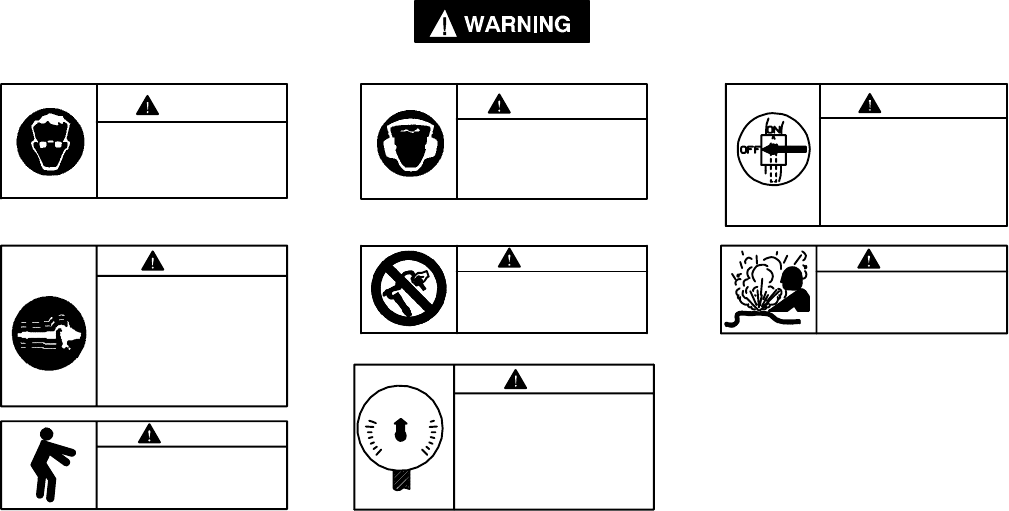
2
WARNING SYMBOL IDENTIFICATION
FAILURE TO OBSERVE THE FOLLOWING WARNINGS COULD RESULT IN INJURY.
Always wear eye protection
when operating or perform-
ing maintenance on this tool.
WARNING
WARNING
Always wear hearing
protection when operating
this tool.
Always turn off the air sup-
ply and disconnect the air
supply hose before instal-
ling, removing or adjusting
any accessory on this tool,
or before performing any
maintenance on this t ool.
WARNING
Air powered tools can vibrate
in use. Vibration, repetitive
motions or uncomfortable
positions may b e harmful to
your hands and arms. Stop
using any tool if discomfort,
tingling feeling or pain occurs.
Seek medical advice before re-
suming use.
WARNING
Do not carry the tool by the
hose.
WARNING
WARNING
Do not use damaged, frayed
or deteriorated air hoses
and f ittings.
WARNING
Keep body stance balanced
and firm. Do not overreach
when operating this tool.
WARNING
Operate at 90 psig (6.2 bar/
620 kPa) Maximum air pres-
sure.
90 psig
(6.2bar/620kPa)
PERCUSSIVE TOOL SPECIFIC WARNINGS
• When wearing gloves and oper a ting models with
inside trigger, always be sure that the gloves will not
prevent the trigger from being released.
• Wear safety s hoe s, hard hat, safety goggles, gloves,
dustmask a nd any other a ppropriate protective
clothing while operating the tool.
• Do not indulge in horseplay. Distraction can cause
accidents.
• Keep hands and fingers away from the throttle lever
until i t is time to operate the tool.
• Never rest the tool or chisel on your foot.
• Never point the tool at anyone.
• Compressed air is dangerous. Never point an air hose
at yourself or co--workers.
• Never blow clothes free of dust with compressed air.
• Be sure all hose connections are tight. A loose hose
not only leaks but can c ome completely off the tool
and while wh ipping under pressure, can injure the
operator and others in the area. Attach safety cables
to a ll hoses to prevent injury in case a hose is
accidentally broken.
• Never disconnect a pressurized air hose. Always turn
off the air supply and bleed the tool before
disconnecting a hose.
• The operator must keep limbs and body clear of the
chisel. If a chisel breaks, the tool with the broken
chisel projecting from the tool will s u ddenly surge
forward.
• Do not ride the tool with one leg over the handle.
Injury can result if the chisel breaks while r iding the
tool.
• Know what is underneath the material being worked.
Be alert for hidden water, gas, sewer, telephone or
electric lines.
• Use only proper cleaning solvents to clean parts. Use
only cleaning solvents which meet current safety and
health standards. Use cleaning solvents in a well
ventilated area.
• Do not flush the tool or clean any parts with diesel
fuel. Diesel fuel residue w ill ignite in the tool when
the tool is operated, causing damage to internal parts.
When using models with outside triggers or throttle
levers, take care when setting the tool down to prevent
accidental operation.
• Do not operate the tool with broken or damaged
parts.
• Never start the tool when it is lying on the ground.










